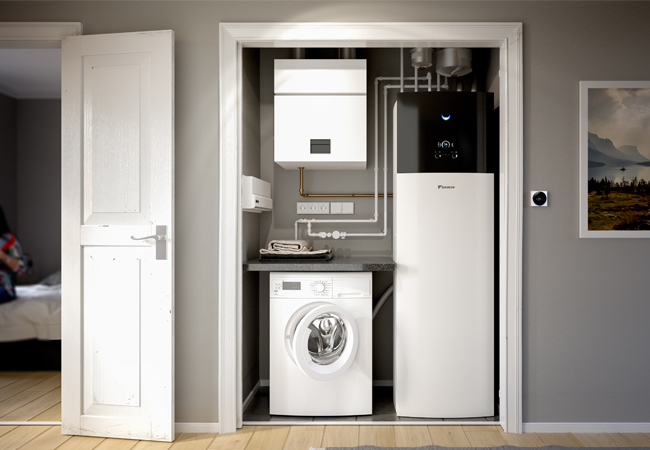
The continued pursuit of greener buildings in the UK demands a comprehensive approach to carbon reduction across all facets of construction. Daikin has prioritised its commitment to the natural environment, placing it at the forefront of its agenda.
The company has dedicated efforts to innovate and introduce products that address the challenges confronting the industry in its quest for a sustainable future.
A key issue in the fight to reduce emissions is in the retrofitting of outdated and inefficient systems in collective multi-function buildings. For these buildings, for example apartments or an office and residential building, a heat interface unit (HIU) will heat the water that is circulated around the entire building, usually with a gas boiler.
Distributing energy throughout the building using near ambient water temperatures reduces the diameter of pipes and requires less insulation on pipework
This ensures that taps and radiators receive instant hot water at all times but a tremendous amount of energy is wasted through maintaining these high temperatures. Additionally, these buildings often require retrofitted cooling systems due to the high amount of heat generated by both the boiler and the circulating water and so, without these cooling systems, the environment within would often be intolerable.
Ambient loop provides a solution to this problem, in which the overall temperature of circulated water is lowered, requiring far less energy to maintain and generating far less dispersed heat. From here, a water-to-water system, such as an Altherma WS, will take this low temperature water and heat it to a high temperature locally and quickly.
With a product like the Altherma WS, you will not only vastly reduce the amount of energy consumed by the heating system, but it will take strain away from any cooling systems.
Daikin Altherma 3 Geo ground source heat pump for heating, cooling & hot water
Systems like the Altherma WS are typically small in stature, usually around a similar size to a fridge freezer, and enable space cooling, heating and hot water through a single central loop. The units can easily be installed in confined spaces, such as a utility cupboard, and there is no requirement for any balcony or outdoor space.
Another key benefit of the technology is that distributing energy throughout the building using near ambient water temperatures reduces the diameter of pipes and requires less insulation on pipework compared to a traditional system.
Heating, hot water and cooling are provided via two pipe networks instead of traditional four pipe solutions. A low temperature heat pump solution offers capital saving on the distribution network over traditional high temperature heating systems.
Ultimately all of these benefits drive toward one key achievement – reduction of CO2 emissions. More and more people across Europe live in an urban area. Numbers from Eurostat show that in 2018, 46% of the EU-27 population lived in flats in those areas.
Apartment buildings are among the most relevant contributors of energy consumption and CO2 emission. Decarbonisation is a key topic in the collective building market as there is a genuine growing demand for living spaces in cities, yet the future of these cities must still be environmentally friendly.
A low temperature heat pump solution offers capital saving on the distribution network over traditional high temperature heating systems
Apartment buildings consume a lot of energy and therefore have high CO2 emissions, and so it is vital to transition to more sustainable means of heating to ensure that ecological footprint remains as small as it can possibly be.
A product that can help to achieve the reduction of CO2 is Daikin’s Altherma 3 WS, a water-sourced heat pump for apartments that works in tandem with a larger air-sourced heat pump to upgrade cool water (20-25oC) to higher temperatures (60-65oC), overall making it a highly efficient communal heat pump system for collective buildings.
The system creates a more sustainable means of providing hot water, heating and cooling to units within a collective building, reducing emissions without compromising on quality or availability of utilities.
There is a demand in the market for this technology, and Daikin offer the systems and solutions to meet the demand. Transitions to these systems must be made if the UK is to meet its net zero goals, and if we are to achieve a more sustainable future.
To find out more visit www.daikin.co.uk or contact ukmarketing@daikin.co.uk.
About the author
Matteo Dall’Ombra is a commercial product manager at Daikin

